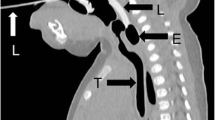Abstract
Background
There has been an increasing tendency for anesthesiologists to be responsible for providing sedation or anesthesia during chest CT imaging in young children. Anesthesia-related atelectasis noted on chest CT imaging has proven to be a common and troublesome problem, affecting image quality and diagnostic sensitivity.
Objective
To evaluate the safety and effectiveness of a standardized anesthesia, lung recruitment, controlled-ventilation technique developed at our institution to prevent atelectasis for chest CT imaging in young children.
Materials and methods
Fifty-six chest CT scans were obtained in 42 children using a research-based intubation, lung recruitment and controlled-ventilation CT scanning protocol. These studies were compared with 70 non-protocolized chest CT scans under anesthesia taken from 18 of the same children, who were tested at different times, without the specific lung recruitment and controlled-ventilation technique. Two radiology readers scored all inspiratory chest CT scans for overall CT quality and atelectasis. Detailed cardiorespiratory parameters were evaluated at baseline, and during recruitment and inspiratory imaging on 21 controlled-ventilation cases and 8 control cases.
Results
Significant differences were noted between groups for both quality and atelectasis scores with optimal scoring demonstrated in the controlled-ventilation cases where 70% were rated very good to excellent quality scans compared with only 24% of non-protocol cases. There was no or minimal atelectasis in 48% of the controlled ventilation cases compared to 51% of non-protocol cases with segmental, multisegmental or lobar atelectasis present. No significant difference in cardiorespiratory parameters was found between controlled ventilation and other chest CT cases and no procedure-related adverse events occurred.
Conclusion
Controlled-ventilation infant CT scanning under general anesthesia, utilizing intubation and recruitment maneuvers followed by chest CT scans, appears to be a safe and effective method to obtain reliable and reproducible high-quality, motion-free chest CT images in children.





Similar content being viewed by others
References
Kim JE, Newman B (2010) Evaluation of a radiation dose reduction strategy for pediatric chest CT. AJR Am J Roentgenol 194:1188–1193
Pappas JN, Donnelly LF, Frush DP (2000) Reduced frequency of sedation of young children with multisection helical CT. Radiology 215:897–899
Sacchetti A, Carraccio C, Giardino A et al (2005) Sedation for pediatric CT scanning: is radiology becoming a drug-free zone? Pediatr Emerg Care 21:295–297
Slovis TL (2011) Sedation and anesthesia issues in pediatric imaging. Pediatr Radiol 41:514–516
Long FR, Castile RG (2001) Technique and clinical applications of full-inflation and end-exhalation controlled-ventilation chest CT in infants and young children. Pediatr Radiol 31:413–422
Stick SM, Brennan S, Murray C et al (2009) Bronchiectasis in infants and preschool children diagnosed with cystic fibrosis after newborn screening. J Pediatr 155:e621
Fleiss JL, Cohen J (1973) The equivalence of weighted kappa and the intraclass correlation coefficient as measures of reliability. Educ Psychol Meas 33:613–619
Rao JN, Scott AJ (1992) A simple method for the analysis of clustered binary data. Biometrics 48:577–585
Korn E, Graubard BI (1998) Confidence intervals for proportions with small expected number of positive counts estimated from survey data. Surv Methodol 24:193–201
Long FR, Williams RS, Adler BH et al (2005) Comparison of quiet breathing and controlled ventilation in the high-resolution CT assessment of airway disease in infants with cystic fibrosis. Pediatr Radiol 35:1075–1080
Lam WW, Chen PP, So NM et al (1998) Sedation versus general anaesthesia in paediatric patients undergoing chest CT. Acta Radiol 39:298–300
Sargent MA, McEachern AM, Jamieson DH et al (1999) Atelectasis on pediatric chest CT: comparison of sedation techniques. Pediatr Radiol 29:509–513
Rothen HU, Sporre B, Engberg G et al (1998) Airway closure, atelectasis and gas exchange during general anaesthesia. Br J Anaesth 81:681–686
Kaditis AG, Motoyama EK, Zin W et al (2008) The effect of lung expansion and positive end-expiratory pressure on respiratory mechanics in anesthetized children. Anesth Analg 106:775–785, table of contents
Edmark L, Auner U, Enlund M et al (2011) Oxygen concentration and characteristics of progressive atelectasis formation during anaesthesia. Acta Anaesthesiol Scand 55:75–81
Serafini G, Cornara G, Cavalloro F et al (1999) Pulmonary atelectasis during paediatric anaesthesia: CT scan evaluation and effect of positive endexpiratory pressure (PEEP). Paediatr Anaesth 9:225–228
Neumann P, Rothen HU, Berglund JE et al (1999) Positive end-expiratory pressure prevents atelectasis during general anaesthesia even in the presence of a high inspired oxygen concentration. Acta Anaesthesiol Scand 43:295–301
Tusman G, Bohm SH, Tempra A et al (2003) Effects of recruitment maneuver on atelectasis in anesthetized children. Anesthesiology 98:14–22
Hanley JA, Lippman-Hand A (1983) If nothing goes wrong, is everything all right? Interpreting zero numerators. JAMA 249:1743–1745
Acknowledgments
Source of funding: The project was supported by the National Center for Research Resources and the National Center for Advancing Translational Sciences, National Institutes of Health, through UL1 RR025744, and by the Lucile Packard Foundation for Children's Health. The content is solely the responsibility of the authors and does not necessarily represent the official views of the NIH.
Conflicts of interest
None.
Author information
Authors and Affiliations
Corresponding author
Rights and permissions
About this article
Cite this article
Newman, B., Krane, E.J., Gawande, R. et al. Chest CT in children: anesthesia and atelectasis. Pediatr Radiol 44, 164–172 (2014). https://doi.org/10.1007/s00247-013-2800-4
Received:
Revised:
Accepted:
Published:
Issue Date:
DOI: https://doi.org/10.1007/s00247-013-2800-4




